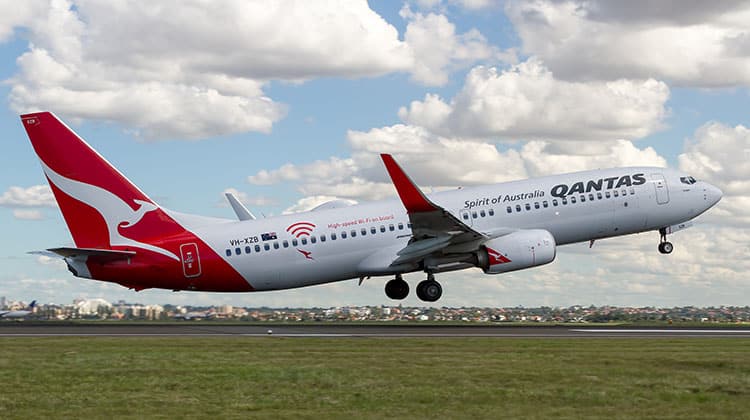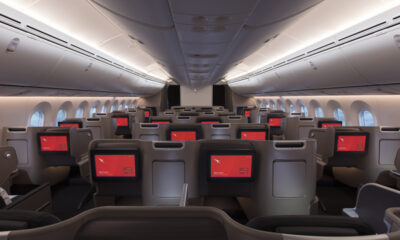Aviation
Qantas eyes the 737 MAX for fleet renewal plans narrowbody, widebody plane orders in 2022

Qantas has entered the final stages of a formal tender process with aircraft and engine manufacturers for the long-term renewal of its domestic narrow-body fleet.
The program, which has been flagged previously, will see more than 100 new aircraft enter the national carrier’s domestic fleet by 2034, renewing the Boeing 737-800s and Boeing 717s that currently form the backbone of its domestic jet operations.
Deliveries would start from the end of 2023 but the Group would retain significant flexibility to make adjustments depending on market conditions.
The aircraft being considered are the Boeing 737 MAX family and Airbus A320neo family, as well as the smaller Embraer E-Jet E2 family and the Airbus A220.
The tender process includes detailed evaluation of the aircraft against four key criteria: safety, reliability and performance, sustainability and emissions reduction, and commercial terms.
Final decisions on preferred suppliers of aircraft and engines are expected to be made by the end of 2021 followed by firm orders by mid-2022.
Insight behind the World’s Top 20 Airlines 2020 by OAG
OTHER FLEET
The Qantas Group has an existing order for 109 Airbus A320/A321 aircraft, which will predominantly be used to renew Jetstar’s exiting fleet of A320 aircraft. The first neo is due to be delivered in the second half of calendar year 2022 with deliveries through to end of the decade.
Three additional 787-9 Dreamliner’s for Qantas International will be delivered from FY23 onwards.
AIRCRAFT INFORMATION
Current fleet
Boeing 737-800
- 75 aircraft in the fleet
- 174 seats – 12 Business, 162 Economy
- Current fleet age is between 7 to 19 years old
- 4,800km range
- Operated on routes ranging from Melbourne-Sydney to Brisbane-Perth
- CFM engines
The B737-800s have been the workhorse of Qantas’ domestic operation for the past 20 years, with fantastic reliability and a product that customers love. The most recent aircraft arrived in 2014 so the 737-800 will continue to fly for Qantas well into the next decade.
Boeing 717
- 20 aircraft in the fleet (mix of two and single class)
- Two configurations:
- Dual class with 110 seats – 12 Business, 98 Economy
- Single class with 125 Economy seats
- Current fleet age is from 15 to 22 years old
- 2,408km range
- Operated on routes such as Brisbane-Canberra and Hobart-Melbourne
- Rolls Royce Deutschland BR-715 engines
The B717s have provided Qantas with the flexibility to service many segments of the domestic market, including regional routes, fly in fly out operations or more frequencies to capital cities.
THE GULFSTREAM G700 SETS INTERNATIONAL CITY-PAIR SPEED RECORDS FOR THE FIRST TIME.
AIRCRAFT BEING EVALUATED
Note: Aircraft information has been sourced from manufacturers’ websites. Specifications are indicative only and not reflective of the specifications of any potential aircraft order by Qantas.
Boeing 737 MAX family
- Consists of the MAX 7, MAX 8, MAX 9 and MAX 10
- Seats range from 138 to 204 seats for two-class configurations
- 6,100km to 7,130km range
- Reduces fuel use and CO2 emissions by 14 per cent compared to the 737-800NG
- 40 per cent quieter than the 737-800NG
- CFM International LEAP-1B engines
Did you know these 10 incredible facts about Honda jet ?
Airbus A320 family
- Includes the Airbus A320neo and A321neo
- A320neo seats – from 150 to 180 for a two-class configuration. 6,300km range
- A321neo seats – from 180 to 220 for a two-class configuration. 7,400km range
- The A320neo family offers fuel improvements of 14 per cent from A320ceos
- 50 per cent quieter than the A320ceos
- Two engine options-Pratt and Whitney PurePower PW1100G and CFM International LEAP-1A
Airbus A220
- Specifically designed for the 100-150 seat market
- 25 per cent lower fuel burn per seat than previous generation aircraft, half the noise footprint, and decreased emissions
- Up to 6,390km range
- Pratt and Whitney PurePower PW1500G engines
Embraer E-Jet E2 family
- E190-E2 seats up to 114 for a single-class configuration. Range is 5,278km
- E195-E2 seats up to 146 for a single-class configuration. Range is 4,815km
- Achieves double digit lower fuel consumption compared to current-generation Embraer jets
- Pratt and Whitney PurePower PW1700G engines

Aerospace
India is set to build a central command for the Air Traffic Control system, called ISHAN

India’s air traffic growth has led to increased responsibilities for air traffic control. The Airports Authority of India (AAI) is considering centralizing air traffic control for aircraft, dividing the country into four regions. The goal is to consolidate India’s segmented airspace into a single entity to improve air traffic management (ATM) efficiency, safety, and smoothness.
Recently, the AAI invited expressions of interest to develop a detailed project report for the Indian Single Sky Harmonized Air Traffic Management (ISHAN) initiative in Nagpur. Under this plan, air traffic controllers in Nagpur would handle domestic flights flying above 25,000 feet, eliminating the need for coordination among controllers in different regions.
For domestic regional flights operating above 25,000 feet, control would shift to the central command in Nagpur. This consolidation aims to enhance airline operations, increase flight handling capacity, and reduce congestion and flight times for passengers.
Currently, the AAI provides ATM services over Indian airspace and adjoining oceanic areas, covering over 2.8 million square nautical miles. This airspace is divided into four flight information regions (FIRs) in Delhi, Mumbai, Kolkata, and Chennai, along with a sub-FIR in Guwahati.
FIRs are responsible for providing air traffic services, including weather information, visibility, and search and rescue assistance. The proposed unification under the ISHAN initiative aligns with the projected growth of the aviation industry, which anticipates a doubling of domestic passenger traffic by 2030.
Aviation
Airbus is set to increase the production rate for the A350 as demand surges

Airbus SE is set to boost production of its advanced A350 widebody jet as it capitalizes on rising demand for long-distance travel and wide-body aircraft, amidst the ongoing crisis affecting its competitor Boeing due to issues with the B737 Max.
The surge in orders for Airbus’s A350 aircraft has instilled confidence in the company, prompting them to ramp up production rates. This move is particularly advantageous as Boeing continues to grapple with production quality issues surrounding its 787 and 777x aircraft.
In 2024 alone, Airbus has received 137 orders for the A350, signaling a need to expand manufacturing capabilities to meet customer demands. With 1,277 orders received and 592 aircraft delivered as of April 2024, Airbus is poised to fulfill pending deliveries efficiently.
The European aircraft manufacturer announced plans to increase production of A350 jets to 12 per month by 2028, surpassing earlier projections aiming for 10 per month by 2026. This decision was disclosed alongside the company’s first-quarter figures.
The Asian market is proving lucrative for the A350, with significant orders from airlines like Indigo and Air India, totaling nearly 70 aircraft commitments for the future. Meanwhile, Airbus is progressing with its A220 and A320 programs, aiming for a monthly production rate of 14 and 75 aircraft, respectively, by 2026. Additionally, the long-range A321XLR is anticipated to commence service in the third quarter of the current year.
In contrast, Boeing has been compelled to scale back production due to regulatory pressures aimed at enhancing factory processes. While Airbus anticipates a positive market outlook, Boeing continues to face challenges with FAA certification and quality approvals, resulting in ongoing delays for its 737 Max and 777x models.
Financially, Boeing reported a significant cash burn of $3.9 billion in the first quarter, leaving it with $7.5 billion in cash and short-term securities by the quarter’s end, down from $16 billion at the beginning of the year. Consequently, Boeing’s stock has plummeted by 38% in the year so far, contrasting with Airbus’s 14% gain, marking Boeing’s lowest performance in over a year.
For a full listing including details on customers and regions, as well as historical data for the previous year, go to the download section below.
- March 2024 deliveries: 63 deliveries to 32 customers
- March 2024 gross orders: 137
- 2024 deliveries to date: 142 deliveries to 45 customers
| Single-Aisle | A300/A310 | A330 | A340 | A350 | A380 | TOTAL | |
|---|---|---|---|---|---|---|---|
| Total Orders | 19470 | 816 | 1774 | 377 | 1277 | 251 | 23965 |
| Total Deliveries | 11705 | 816 | 1598 | 377 | 592 | 251 | 15339 |
| Aircraft in Operation | 11007 | 271 | 1482 | 202 | 591 | 234 | 13787 |
Aviation
All passengers killed in plane crash, after pilot let his children to control the plane

When boarding a plane, passengers entrust their safety to the skilled hands of the pilot. However, tragedy struck when one of the flight ended in disaster as all passengers lost their lives in a horrific plane crash.
In 1994, during a flight from Moscow to Hong Kong, tragedy struck as an Aeroflot relief pilot made a fateful decision. In a move that would have devastating consequences, the pilot invited his own children into the cockpit to play with the controls. Little did anyone know, this seemingly innocent gesture would lead to the loss of all 75 lives aboard the aircraft.
It was a seemingly innocent act that led to catastrophic results. The relief pilot, Mr. Kudrinsky, invited his two children, Yana, 12, and Eldar, 15, into the cockpit during the late hours of the night. Little did anyone know, this simple gesture would set off a chain of events that would end in tragedy.
Once in the cockpit, the children were allowed to sit in the captain’s chair and play with the controls, unaware that they should have been disabled as the plane was in autopilot mode.
Eldar, perhaps in a moment of curiosity or innocence, held the control column down for a mere 30 seconds. Yet, in those brief moments, the autopilot disengaged, thrusting the aircraft into manual control.
By the time the pilots regained their seats and attempted to regain control, it was too late. Despite their efforts to pull the plane out of a dive, they overcorrected, causing the flight to climb almost vertically, ultimately stalling it.
Final moment Flight 593 crash
In the final moments, as the pilots struggled to stabilize the aircraft, Flight 593 crashed into the Kuznetsk Alatau Mountain range in southern Russia, completely obliterating the plane and claiming the lives of everyone on board.
Investigations revealed a chilling truth: there was no evidence of technical failure. Instead, the crash was attributed to the unthinkable decision to allow inexperienced hands to manipulate the controls of a commercial aircraft.
The black box recording captured the harrowing sequence of events, providing a grim reminder of the human cost of a lapse in judgment. In just over two minutes, the lives of all on board were tragically short, leaving behind a legacy of sorrow and unanswered questions.




























